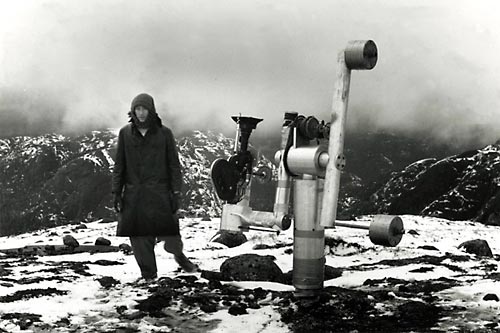Das Filmforum der HBK präsentiert im Wintersemester 2016/17:
Montag | 31.10.16 | 19:00 h
Michael Snow – La Région Centrale
„Dieser Film ist keine 'Unterhaltung'. Er ist ein Phänomen. Er kann das Mittel einer Offenbarung sein. Um wirklich erfahren zu werden, sollte der Film in seiner vollen Länge gesehen und gehört werden. Die mittlere Stunde ist ein Plateau, dessen Natur man verstehen wird, wenn man es durchschritten hat, d.h. wenn man von der anderen Seite des Endes zurückschaut (eine ungewöhnliche Gelegenheit). Nehmen Sie sich Zeit, nehmen Sie Ihren Platz ein. Es ist zu erwarten, daß nicht jeder in den Film eindringen wird. Bleiben Sie, schauen Sie auf das Bild, aber denken Sie an etwas anderes. Später werden Sie vielleicht herausfinden, daß Sie wieder zu den Bildern zurückgekehrt sind.“ (Michael Snow; arsenal distribution)

Michael Snow – La Région Centrale
191 min | 1971 | 16mm | col | sound | OV (nodialog) | CA
"La Région Centrale" was made during five days of shooting on a deserted mountain top in North Quebec. During the shooting, the vertical and horizontal alignment as well as the tracking speed were all determined by the camera's settings. Anchored to a tripod, the camera turned a complete 360 degrees, craned itself skyward, and circled in all directions. Because of the unconventional camera movement, the result was more than merely a film that documented the film location's landscape. Surpassing that, this became a film expressing as its themes the cosmic relationships of space and time. Cataloged here were the raw images of a mountain existence, plunged (at that time) in its distance from civilization, embedded in cosmic cycles of light and darkness, warmth and cold.
La Région Centrale (Quebec, 1971, 180 min., 16mm, color) is arguably the most spectacular experimental film made anywhere in the world, and for John W. Locke, writing in Artforum in 1973, it was "as fine and important a film as I have ever seen." If ever the term "metaphor on vision" needed to be applied to a film it should be to this one. Following Wavelength, Michael Snow continued to explore camera/frame movement and its relationships with space and time in Standard Time (1967) an eight minute series of pans and tilts in an apartment living room and (Back and Forth) (196869), a more extended analysis. But with La Région Centrale, Snow managed to create moving images that heretofore could no possibly be observed by the human eye. For this project he enlisted the help of Pierre Abaloos to design and build a machine which would allow the camera to move smoothly about a number of different axes at various speeds, while supported by a short column, where the lens of the camera could pass within inches of the ground and zoom into the infinity of the sky. Snow placed his device on a peak near Sept Îsles in Quebec's Région centrale and programmed it to provide a series of continuously changing views of the landscape. Initially, the camera pans through 360° passes which map out the terrain, and then it begins to provide progressively stranger views (on its side, upside down) through circular and back-and-forth motions.
The weird soundtrack was constructed from the electronic sounds of the programmed controls which are sometimes in synch with the changing framing on screen and sometimes not. Here, allusions to other films occur, especially science fiction works like Stanley Kubrick's 2001: A Space Odyssey (1968) which similarly reveals a barren, human-less primal landscape (with odd sounds) and spatially disorients the spectator. In La Région Centrale's second hour, the world is inverted for so long, that when the camera swings vertically through a full circle to restore the horizon line to its rightful position, above the earth, it looks wrong. In the complete absence of human or animal forms, one can imagine the outlines of animals in the silhouetted shapes of rocks at twilight. It is impossible not to notice "camera movement" in this film, and, as Locke notes, one is inclined to observe the frame edge leading the movement (rather than the center) much of the time.
I can only imagine what it would have been like to see La Région Centrale, captivated in the extreme dark and quiet of New York's Anthology Film Archive theater built specifically for the screening of experimental films in the 1970s. But, in any event, seen under any condition, the last hour offers up an incredible experience, with unbelievably high speed twisting and swirling motions rendering dynamic color and line abstractions. Finally, by rephotography ‹of the film jumping out of the gate‹ and flaring out of the image to red and yellow colors, and, closing with the camera apparently motionless on the sun, Snow presents a reflexive impression of the camera as the ultimate transformative, creative apparatus, capable of any magic. La Région Centrale presents a definitive "metaphor on vision."
(StrokeHole, www.youtube.com, Uploaded on Nov 19, 2008)
[ Abbildung oben: aus dem Film „La Région Centrale“ von Michael Snow ]